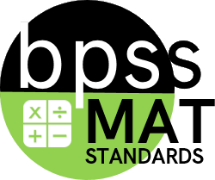BPS District Mathematics Standards Book
Math Learning Progressions
[N] Number and Quantity
Math Learning Progressions HS Math Concepts
[N] Number and Quantity
| K | 1 | 2 | 3 | 4 | 5 | 6 | 7 | 8 |
| [CC] Counting and Cardinality |
||||||||
| [NBT] Number and Operations in Base Ten |
[RP] Ratios and Proportional Relationships |
|||||||
| [NF] Number and Operations - Fractions |
[NS] The Number System |
|||||||
Students’ prior knowledge includes:
- Students know that there are numbers that are not rational, and approximate them by rational numbers (grade 8)
- Students apply and extend previous understandings of operations with fractions to add, subtract, multiply, and divide rational numbers (grade 7)
The Real Number System
- Extend the properties of exponents to rational exponents.
- Use properties of rational and irrational numbers.
Quantities
- Reason quantitatively and use units to solve problems
The Complex Number System
- Perform arithmetic operations with complex numbers.
- Represent complex numbers and their operations on the complex plane.
- Use complex numbers in polynomial identities and equations
Vector and Matrix Quantities
- Represent and model with vector quantities.
- Perform operations on vectors.
- Perform operations on matrices and use matrices in applications.
MAT-HS.N Overview: [N] Number and Quantity
MAT-HS.N-RN Domain: [N-RN] The Real Number System
-
- MAT-HS.N-RN.01 Explain how rational exponents are like integer exponents with radical notation
- MAT-HS.N-RN.02 Apply properties of exponents to expressions with radicals/rational exponents
- MAT-HS.N-RN.03 Explain which sums or products of two numbers are rational or irrational, why
- MAT-HS.N-RN.04 Perform basic operations on radicals and simplify radicals to write equivalent expressions
MAT-HS.N-Q Domain: [N-Q] Quantities*
-
- MAT-HS.N-Q.01 Use units to understand and guide the solution of multi-step problems
- MAT-HS.N-Q.02 Define appropriate quantities for the purpose of modeling
- MAT-HS.N-Q.03 Report quantities at a level of accuracy reflecting limitations on measurement
MAT-HS.N-CN Domain: [N-CN] The Complex Number System
-
- MAT-HS.N-CN.01 Know that every complex number has the form a + bi with a and b real
- MAT-HS.N-CN.02 Use the relation i^2 1 and commutative/associative/distributive properties
- MAT-HS.N-CN.03 Find the conjugate of a complex number
- MAT-HS.N-CN.04 Represent complex numbers on complex plane in rectangular and polar form
- MAT-HS.N-CN.05 Represent +, , x, and conjugation of complex numbers geometrically
- MAT-HS.N-CN.06 Calculate the distance between numbers in the complex plane
- MAT-HS.N-CN.07 Solve quadratic equations with real coefficients that have complex solutions
- MAT-HS.N-CN.08 Extend polynomial identities to the complex numbers
- MAT-HS.N-CN.09 Show the Fundamental Theorem of Algebra is true for quadratic polynomials
MAT-HS.N-VM Domain: [N-VM] Vector and Matrix Quantities
-
- MAT-HS.N-VM.01 Recognize vector quantities as having both magnitude and direction
- MAT-HS.N-VM.02 Find the components of a vector by subtracting the coordinates
- MAT-HS.N-VM.03 Solve problems involving velocity that can be represented by vectors
- MAT-HS.N-VM.04 Add and subtract vectors
- N-VM.04.a Add vectors end-to-end, componentwise, and by the parallelogram rule
- N-VM.04.b Given two vectors, determine the magnitude and direction of their sum
- N-VM.04.c Understand vector subtraction
- MAT-HS.N-VM.05 Multiply a vector by a scalar
- N-VM.05.a Represent and perform scalar multiplication graphically by scaling vectors
- N-VM.05.b Compute the magnitude of a scalar multiple
- MAT-HS.N-VM.06 Use matrices to represent and manipulate data
- MAT-HS.N-VM.07 Multiply matrices by scalars to produce new matrices
- MAT-HS.N-VM.08 Add, subtract, and multiply matrices of appropriate dimensions
- MAT-HS.N-VM.09 Understand matrix multiplication for square matrices is not commutative
- MAT-HS.N-VM.10 Understand that the 0 and identity matrices play a role in matrix + and x
- MAT-HS.N-VM.11 Multiply a vector by a matrix to produce another vector
- MAT-HS.N-VM.12 Work with 2 x 2 matrices as transformations of the plane
A Sample of HS Math Concept Number and Quantity to Become Ready for College and Career
The Real Number System
- Extend the properties of exponents to rational exponents.
- Use properties of rational and irrational numbers.
Quantities
- Reason quantitatively and use units to solve problems.
The Complex Number System
- Perform arithmetic operations with complex numbers.
- Represent complex numbers and their operations on the complex plane.
- Use complex numbers in polynomial identities and equations.
Vector and Matrix Quantities
- Represent and model with vector quantities.
- Perform operations on vectors.
- Perform operations on matrices and use matrices in applications.
